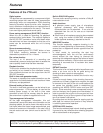
6
Features
Features of the camera unit
Prime lens mode
Not only the lens that does justice to the sensitivity
equivalent to a film but also the various devices and
equipment that are peripheral to the camera combine to
play roles which are so critical that they cannot be
divorced from the technical skills of the person operating
the camera. Using an HD lens adapter made by
Angenieux, this unit supports the ultra-prime lenses used
for film cameras as a standard feature. What’s more,
Panasonic has achieved an industry first by incorporating
as a standard feature, a scan reverse function, which
cancels out image reversal occurring when the adapter is
used, and switching can be easily accomplished by a
menu setting.
The unit also supports slide bases, matte boxes and
other film camera equipment which users may have been
using for years.
A full range of long viewfinders, small LCD monitors and
other options available from related manufacturers is
available, and the maximum can be derived from formats
ranging from films to HD with the same ease afforded by
simply changing the main camera unit.
Film user menu
Panasonic does its best to cater to film camera users not
only on the functions and performance front but also in
terms of operation.
For instance, it has provided a cinema image menu
(FILM USER MENU) which brings together on one page
the setting items that are frequently used in location
cinema shooting.
Along with the gamma curve selection and scan reverse
ON/OFF functions, the settings for the hard and soft
texture adjustments, gradation settings for the shadow
areas, latitude adjustments, and tungsten lighting
(3200K) type or daylight (5600K) type can be selected
just like with films on one menu screen.
Digital signal processing
Analog signals are converted into digital signals through
10-bit A/D conversion at a sampling frequency of
74.1758 MHz (59.94 Hz)/74.25 MHz (60.0Hz).
This processing not only enhances the picture quality,
stability and reliability but it also enables the viewfinder
screen displays and many of the adjustment and setup
items to be configured in a menu-driven format.
4-piece filter disc sets available as standard
accessories
The filter best suited to the subject’s brightness and color
temperature can be selected. Two independent sets of
filter discs, one for CC and one for ND, each with four
filter discs, are provided as standard accessories.
Camera unit equipped to capture a wide range of
image creation activities from cinema production
to broadcasting applications
OA sensitivity of F12 (2000 lux) achieved by the three
highly sensitive CCDs.
The minimum subject brightness is 0.7 lux.
OGamma curves (switchable) for reproducing film
tones.
ONot only a natural choice like 24 fps (frame/sec.) for
films but also any number of shooting frames from
4 fps to 60 fps can be set.
ODigital setup for controlling image production using
numerical values and for simple operation using the
jog dial and gradation menu.
OCinema image menu provided for film producers.
OSetup data in up to 8 files can be stored on an SD
card (optional accessory: RP-SD008B).
OBuilt-in high picture quality circuits including auto
knee, many different detail functions, shading
compensation, 12-axis color compensation circuit
and masking circuit.
OBuilt-in 2-level zebra pattern and spot zebra
functions.
O3 values among the 10 possible settings from –6 dB
(–3 dB in film mode) to +30 dB allocated to the gain
selector; also, the gain can be increased up to +36
dB by the super gain function.
OThe following functions can be allocated to the
USER1 and USER2 buttons: super iris, super gain,
super black, black stretch, audio CH1/CH2 input
front/rear switching, recording start/stop, return
switch, and Y GET (output luminance level
measurement).
OAn electronic shutter with a variable function
over and above the 6 shutter speeds.
OTungsten lighting (3200K) type or daylight (5600K)
type can be selected just like with films on one
menu screen. Two sets of ND&CC optical filters
are featured as a standard option.
OABB (automatic black balance) and AWB
(automatic white balance) functions incorporated.
Two values for each of the four CC filters can be
retained as the AWB values.
OStatuses and warnings are displayed on the
viewfinder screen.
1/100 , 1/120, 1/250, 1/500, 1/1000 and 1/2000 sec.
(or 180.0, 172.8, 144.0, 120.5, 90.0 and 45.0 deg)
0.8% to 97.2% of the frame rate (aperture angle of 3.0 to
350.0 degrees)


















